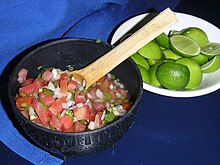| This article needs additional citations for verification. Please help improve this article by adding citations to reliable sources. Unsourced material may be challenged and removed. Find sources: "Pico de gallo" – news · newspapers · books · scholar · JSTOR (March 2017) (Learn how and when to remove this message) |


Pico de gallo (Spanish pronunciation: [ˈpiko ðe ˈɣaʝo], lit. 'rooster's beak'), also called salsa fresca ('fresh sauce'), salsa bandera ('flag sauce'), and salsa cruda ('raw sauce'), is a type of salsa commonly used in Mexican cuisine. It is traditionally made from chopped tomato, onion, and serrano peppers (jalapeños or habaneros may be used as alternatives), with salt, lime juice, and cilantro.
Pico de gallo can be used in much the same way as Mexican liquid salsas. Because it contains less liquid, it also can be used as a main ingredient in dishes such as tacos and fajitas.
The tomato-based variety is widely known as salsa picada ('minced/chopped sauce'). In Mexico it is normally called salsa mexicana ('Mexican sauce'). Because the colors of the red tomato, white onion, and green chili and cilantro are reminiscent of the colors of the Mexican flag, it is also called salsa bandera ('flag sauce').
In many regions of Mexico the term pico de gallo describes any of a variety of salads (including fruit salads), salsa, or fillings made with tomato, tomatillo, avocado, orange, jícama, cucumber, papaya, or mild chilis. The ingredients are tossed in lime juice and optionally with either hot sauce or chamoy, then sprinkled with a salty chili powder.
Etymology
Many native residents of the Sonoran Mexico region explain that the salsa is thus named because the serrano pepper resembles a rooster's beak in shape.
According to food writer Sharon Tyler Herbst, pico de gallo ("rooster's beak") is named thus because originally people ate it by pinching pieces between the thumb and forefinger.
In their book Authentic Mexican: Regional Cooking from the Heart of Mexico, Rick Bayless and Deann Groen speculate that the name might allude to the bird-feed–like texture and appearance of the mince.
See also
- Dabu-dabu
- Lomi salmon
- Pebre
- Vinagrete
- Xnipec
- Afghan salad, a similar salad from Afghanistan
- Arab salad, a similar salad from the Arab world
- Çoban salatası, a similar salad from Turkey
- Greek salad, a similar salad from Greece
- Israeli salad, a similar salad from Israel
- Kachumbari, a similar salad from East Africa
- Kachumber, a similar salad from India
- Serbian salad, a similar salad from Serbia
- Shirazi salad, a similar salad from Iran
- Shopska salad, a similar salad from Bulgaria
- List of Mexican dishes
- List of tomato dishes
References
- Wilder, Janos. The Great Chiles Rellenos Book. Ten Speed Press, 2013.
- Sharon Tyler Herbst, Food Lover's Companion, 2nd ed., as quoted in Barron's Educational Services, Inc. 1995: www.Epicurious.com, retrieved 10/3/2007 pico de gallo
- Bayless, Rick; Groen, Deann. Authentic Mexican: Regional Cooking from the Heart of Mexico.
External links
 Pico de Gallo at the Wikibooks Cookbook subproject
Pico de Gallo at the Wikibooks Cookbook subproject
| Condiments | ||
|---|---|---|
| Sauces |
|  |
| Dips | ||
| Pickles and preserves | ||
| Spreads and pastes | ||
| Oils and liquids | ||
| Spices and powders | ||
| Salads | ||
| Dressings | ||
| Ketchups | ||
| Mustards | ||
| Vinegars | ||
| List articles | ||
| Accoutrements | ||
| Mexican cuisine | |||||||||||
|---|---|---|---|---|---|---|---|---|---|---|---|
| List of Mexican dishes | |||||||||||
| Soups and stews | 
 | ||||||||||
| Rice and pasta dishes | |||||||||||
| Bean dishes | |||||||||||
| Egg dishes | |||||||||||
| Vegetable dishes | |||||||||||
| Meat dishes |
| ||||||||||
| Other protein dishes | |||||||||||
| Cheese dishes | |||||||||||
| Antojitos |
| ||||||||||
| Sauces and condiments | |||||||||||
| Desserts and sweets | |||||||||||
| Salads | |||||||||||
| Breads | |||||||||||
| Beverages | |||||||||||
| Variants |
| ||||||||||









